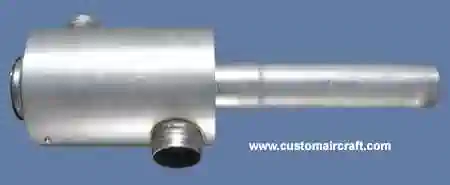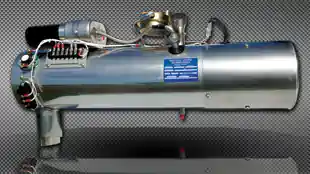Cabin Heating Systems:
-
Exhaust Manifold Heat Exchanger:
- Inlet air is bypassed through an exhaust shroud
- Air is ducted from exhaust shroud, now heated, into ventilation ducts inside of the cabin [Figure 1]
-
Combustion Heater:
- Uses fuel from the aircraft fuel system to support a flame in a designated heater unit
- Air enters the combustion chamber by use of a fan or ram air where it is then burned inside a shroud [Figure 2]
- The resulting warm air from the shroud is routed into the cabin while the exhaust gas is vented overboard
- Heat is regulated with a thermostat
-
Coolant Heat Exchanger:
- Coolant from the engine's cooling system is fed into the cabin and to a heat exchanger
- This heat exchanger blows air across a radiator, heating the air, and therefore the cabin
- This system is uncommon because it requires engines be liquid cooled when most are in fact air cooled
- This system is the same as that in your car
-
Cabin Heat Malfunctions:
- Exhaust pipes may burst allowing carbon monoxide to enter the cabin
- Heaters may have the same problem with the internal combustor
Common Training Aircraft Heating and Cooling Characteristics:
-
Cessna 172:
- Temperature and intensity adjusted with push-pull labeled CABIN HT and CABIN AIR
- Air enters from wing and nose inlet vents
- Air heated with a heat exchanger with a shroud over exhaust pipes
-
Piper Arrow:
- Temperature and intensity adjusted with sliders
- Air enters from wing and nose inlet vents
- Air is heated with a heat exchanger with a shroud over exhaust pipes
- Additional air enters from the aft fuselage
Private Pilot - Operation of Aircraft Systems Airman Certification Standards:
- To determine that the applicant exhibits satisfactory knowledge, risk management, and skills associated with the safe operation of systems on the airplane provided for the flight test
- References: FAA-H-8083-2, FAA-H-8083-3, FAA-H-8083-23, FAA-H-8083-25; POH/AFM
- Lesson Plan
Operation of Aircraft Systems Knowledge:
The applicant must demonstrate an understanding of:PA.I.G.K1:
Airplane systems, to include: (Note: If K1 is selected, the evaluator must assess the applicant's knowledge of at least three of the following sub-elements-
PA.I.G.K1a:
Primary flight controls -
PA.I.G.K1a:
Secondary flight controls -
PA.I.G.K1c:
Powerplant and propeller -
PA.I.G.K1d:
Landing gear -
PA.I.G.K1e:
Fuel, oil, and hydraulic -
PA.I.G.K1f:
Electrical -
PA.I.G.K1g:
Avionics -
PA.I.G.K1h:
Pitot-static, vacuum/pressure, and associated flight instruments -
PA.I.G.K1i:
Environmental -
PA.I.G.K1j:
Deicing and anti-icing -
PA.I.G.K1k:
Water Rudders -
PA.I.G.K1l:
Oxygen Systems
-
PA.I.G.K2:
Indications of and procedures for managing system abnormalities or failures
Operation of Aircraft Systems Risk Management:
The applicant demonstrates the ability to identify, assess, and mitigate risks, encompassing:PA.I.G.R1:
Failure to detect system malfunctions or failuresPA.I.G.R2:
Improper management of a system failurePA.I.G.R3:
Failure to monitor and manage automated systems
Operation of Aircraft Systems Skills:
The applicant demonstrates the ability to:PA.I.G.S1:
Operate at least three of the systems listed in K1a through K1l above appropriatelyPA.I.G.S2:
Use appropriate checklists properly
Conclusion:
- Carbon Monoxide Poisoning in a silent killer who's risk can be mitigated through a few simple steps
- Especially in winter months, refresh your knowledge on Carbon Monoxide and conduct an extra thorough preflight
- Remember, the heater system may have gone unused for months
- You can find more information about your aircraft in Chapter 7 of the Pilot Operating Handbook
- Still looking for something? Continue searching:

